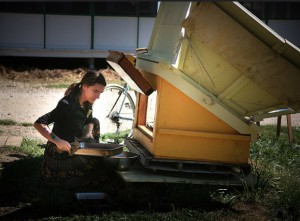
In this second installment in her series on Ecological Cooking, Dancing Rabbit member Sam offers solar oven information and cooking tips.
On a sunny day at Dancing Rabbit, it’s hard to miss, or forget, the unfurled reflective panels of solar ovens being used in front of homes and buildings throughout the village.
We have one very large solar oven in our courtyard, central to several kitchens. It’s big enough for several large pans of food at once, and available to anyone who wishes to use it. Many individual families and co-ops have smaller solar ovens, some home-made, and several Sun Oven brand, which are available online and a pretty solid little go-to oven for single family size eating co-ops.
If you want to build your own solar oven, the internet is abundant with instructions to suit almost any purpose or budget.
Most of us are familiar with the concept: on a sunny day the interior of a car acts like a solar oven. The sun radiates energy through the glass, where it is trapped and heat builds up. In a solar oven that heat can be captured and put to use for cooking.
Cooking in solar ovens required a little more patience, planning, and luck than cooking in a propane or wood-fired oven. Solar ovens only work on sunny days, and as the sun’s position in the sky changes with the time of day, it helps to periodically turn the oven to intercept the sun’s rays most perpendicularly.
On the other hand, solar ovens use no fuel, create no air pollution, and dump no heat into the kitchen, making it a no-brainer for slow-cooked meals on sunny summer days. Given good insulation and seals, the captured heat accumulates, and effectively cooks anything you could cook in a propane or natural gas oven, up to about 300-350°F.
The easiest things to cook in the sun oven are those that won’t suffer from occasional drops in temperature due to a cloudy spell or imperfect aiming. Granola, bar cookies, batter breads, stews, and grains are the foods I see most often in our solar ovens.
Yeast breads do fine, though they take a little longer to bake than in a hotter oven, and might be less forgiving. Drop cookies work pretty well, too. When the forecast is sunny, there’re abundant options for solar oven meals, and that’s not to mention that a solar oven can be used to purify water by boiling or evaporation, or simply heat it enough for bathing or dish washing.
Be careful cooking beans in the solar oven, especially kidney beans,
because if you don’t get them up to 212°F, you might experience food
poisoning caused by hemagglutinin, a naturally-occurring chemical. To
make matters worse, if your bean temperature reaches 175°F, that will
actually increase the toxicity. A way around that problem is to boil
your beans on the stove for 10 minutes to destroy the toxin before
adding them to the dish in your solar oven.
There’s some disagreement among Rabbits over the absolute best type of cookware for use in a solar oven, but there are some universal understandings. Most importantly, your solar oven dish should fit in your solar oven. Finding just the right shape dish can be the quest of many a flea market excursion.
Next, anything very reflective, like shiny silver or white, is out, because if the light is being reflected off the dish, it’s not being absorbed and re-emitted as heat into the food. (Reflection can be useful outside the oven: having reflective panels that aim even more light into the oven can be a big help.)
Also important, especially for stews and casseroles, is a well-fitting lid, both to keep the heat and moisture in the food, but also to keep the glass from steaming up and blocking the sunlight from getting in. The right shape, the right albedo, plus a fitting lid? You’ve got a good enough solar oven dish.
Beyond those basics are a couple of choices. As to whether the lid should be clear or dark colored and opaque, my assessment is that it probably only makes a little difference, and one might be better in some situations and the other in others. Try both yourself and see what works for you.
Then there’s the question of thermal mass. Some folks like heavy dishes and others thinner. The former will hold more heat in the dish, ameliorating changes in temperature caused by clouds or the sun’s movement, while the latter will heat up faster. Which is best for you will depend on your cooking style, the weather, and what you intend to cook. Either will probably work, so don’t worry too much about it.
Building a very simple solar oven is the work of an afternoon, and could be a good hands-on science lesson for kids. A more involved version, with tight seals, good insulation, and abundant interior volume, could be an excellent investment against future energy bills, and a positive step toward a more sustainable lifestyle and a less polluted environment.
• • •
 Sam’s had experience as a scientist, a sailor, a dive guide, a bartender, a housewife, a teacher, a farmer, a vagabond, and a business owner before coming to live at Dancing Rabbit in 2009 with her son. Now Sam spends her time working online, homeschooling, watching Netflix, doing committee work for DR, reading, writing, running a couple of tiny businesses, doing humey for hire, and occasionally gardening.
Sam’s had experience as a scientist, a sailor, a dive guide, a bartender, a housewife, a teacher, a farmer, a vagabond, and a business owner before coming to live at Dancing Rabbit in 2009 with her son. Now Sam spends her time working online, homeschooling, watching Netflix, doing committee work for DR, reading, writing, running a couple of tiny businesses, doing humey for hire, and occasionally gardening.
